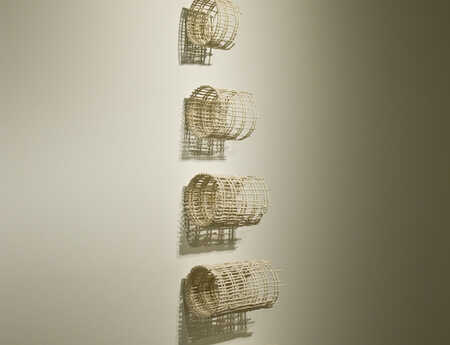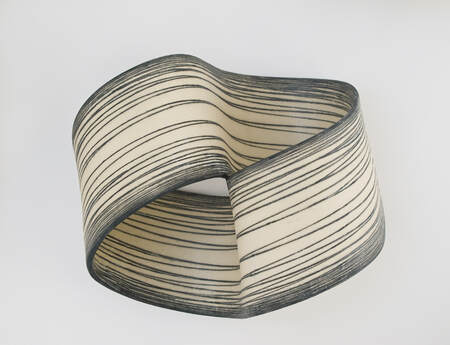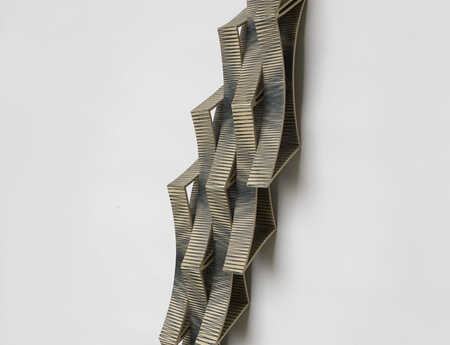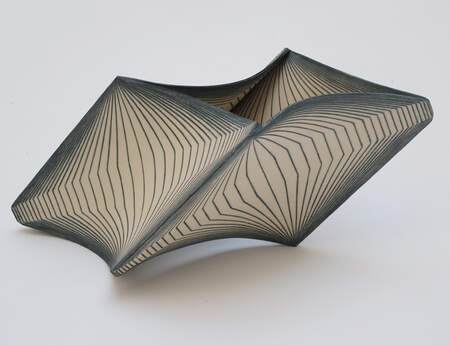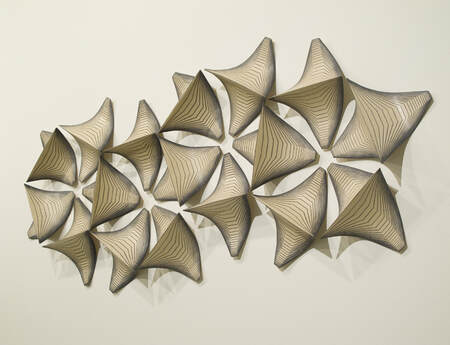
Spain
María Oriza
The vacuum has been in the genesis of my work as a container for the inmaterial.
This is a direct consequence of my understanding by building up the volume based on: cutting, joining, bending, folding, looking for symmetry or asymmetry and repetition.
All these physical actions directly affect the material defining the flow of shape and setting the language that describes part of the content. From this analysis, multiple symbolic and metaphorical connotations arise.
This method of achieving volume from a flat surface, offers the possibility to fill the vacuum created with meaning and clearly perceive the energy that flows between interior and exterior along with the various surfaces of the walls.
Intervention through drawing lines, nets, or patterns are repetitive elements in the surface that serves to demonstrate the formal structure of the volume, giving it unity and coherence.
When approaching installations, I explore space occupation through repeating elements, the resulting work is similar to the growth of abstract nature. The drawing surface changes through the viewers movement and changing perspective, brings with it many connotations extending the shape´s limitation.
En la génesis de mi obra se encuentra el vacío como contenedor de lo inmaterial.
Esto es consecuencia directa de mi manera de entender y construir el volumen partiendo del plano: cortando, uniendo, curvando, plegando, buscando simetrías, asimetrías y repeticiones.
Todas estas acciones físicas recalan directamente en el material definiendo el fluir de la forma y configurando el lenguaje que describe parte del contenido de la obra. De este análisis se desprenden múltiples connotaciones simbólicas y metafóricas.
Este procedimiento de lograr volumen a partir de un plano, ofrece la posibilidad de llenar de significado el vacío que se genera y de percibir con nitidez la energía que fluye entre interior-exterior y en las distintas superficies de sus paredes.
La intervención a través del dibujo con líneas, redes, retículas son elementos reiterativos en la superficie sirve para evidenciar la estructura formal del volumen dotándolo de unidad y coherencia.
En los trabajos de instalación, investigo la ocupación del espacio a través de elementos de repetición, el trabajo resultante se asemeja al de crecimiento de una naturaleza abstracta. El dibujo de la superficie cambia a través del movimiento de los espectadores y del cambio de perspectiva aportando multitud de connotaciones ampliando los límites de la forma.
This is a direct consequence of my understanding by building up the volume based on: cutting, joining, bending, folding, looking for symmetry or asymmetry and repetition.
All these physical actions directly affect the material defining the flow of shape and setting the language that describes part of the content. From this analysis, multiple symbolic and metaphorical connotations arise.
This method of achieving volume from a flat surface, offers the possibility to fill the vacuum created with meaning and clearly perceive the energy that flows between interior and exterior along with the various surfaces of the walls.
Intervention through drawing lines, nets, or patterns are repetitive elements in the surface that serves to demonstrate the formal structure of the volume, giving it unity and coherence.
When approaching installations, I explore space occupation through repeating elements, the resulting work is similar to the growth of abstract nature. The drawing surface changes through the viewers movement and changing perspective, brings with it many connotations extending the shape´s limitation.
En la génesis de mi obra se encuentra el vacío como contenedor de lo inmaterial.
Esto es consecuencia directa de mi manera de entender y construir el volumen partiendo del plano: cortando, uniendo, curvando, plegando, buscando simetrías, asimetrías y repeticiones.
Todas estas acciones físicas recalan directamente en el material definiendo el fluir de la forma y configurando el lenguaje que describe parte del contenido de la obra. De este análisis se desprenden múltiples connotaciones simbólicas y metafóricas.
Este procedimiento de lograr volumen a partir de un plano, ofrece la posibilidad de llenar de significado el vacío que se genera y de percibir con nitidez la energía que fluye entre interior-exterior y en las distintas superficies de sus paredes.
La intervención a través del dibujo con líneas, redes, retículas son elementos reiterativos en la superficie sirve para evidenciar la estructura formal del volumen dotándolo de unidad y coherencia.
En los trabajos de instalación, investigo la ocupación del espacio a través de elementos de repetición, el trabajo resultante se asemeja al de crecimiento de una naturaleza abstracta. El dibujo de la superficie cambia a través del movimiento de los espectadores y del cambio de perspectiva aportando multitud de connotaciones ampliando los límites de la forma.
